The Samsung 850 EVO 4TB SSD Review
by Billy Tallis on July 11, 2016 10:00 AM ESTRandom Read Performance
The random read test requests 4kB blocks and tests queue depths ranging from 1 to 32. The queue depth is doubled every three minutes, for a total test duration of 18 minutes. The test spans the entire drive, which is filled before the test starts. The primary score we report is an average of performances at queue depths 1, 2 and 4, as client usage typically consists mostly of low queue depth operations.
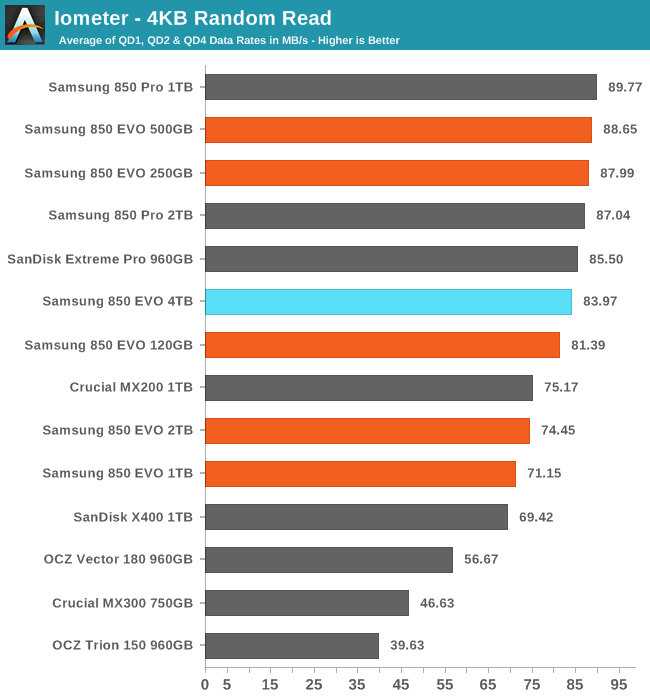
Random read performance of the 4TB 850 EVO is substantially better than the 1TB and 2TB 850 EVOs, but still not quite as fast as the best MLC drives or the 500GB and 250GB 850 EVOs.

The power consumption of the 4TB 850 EVO is slightly higher than the 2TB model, but overall the efficiency is improved over the smaller drive with the same controller but older NAND.
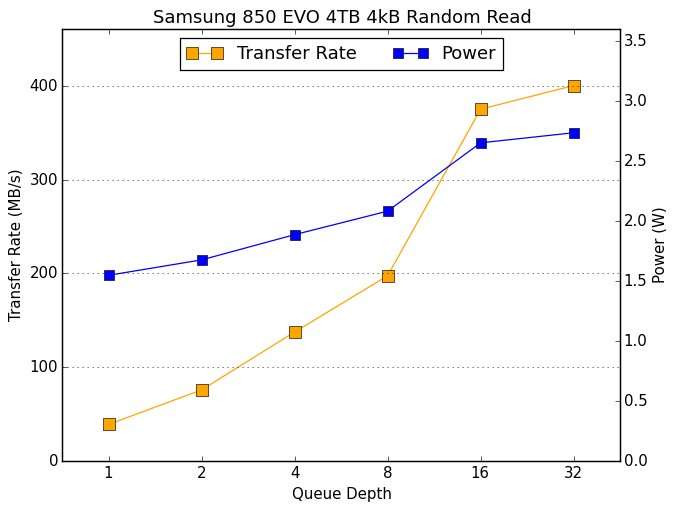 |
|||||||||
The scaling behavior of the 4TB 850 EVO is almost identical to the 2TB model, just with slightly higher performance and power consumption across the board.
Random Write Performance
The random write test writes 4kB blocks and tests queue depths ranging from 1 to 32. The queue depth is doubled every three minutes, for a total test duration of 18 minutes. The test is limited to a 16GB portion of the drive, and the drive is empty save for the 16GB test file. The primary score we report is an average of performances at queue depths 1, 2 and 4, as client usage typically consists mostly of low queue depth operations.
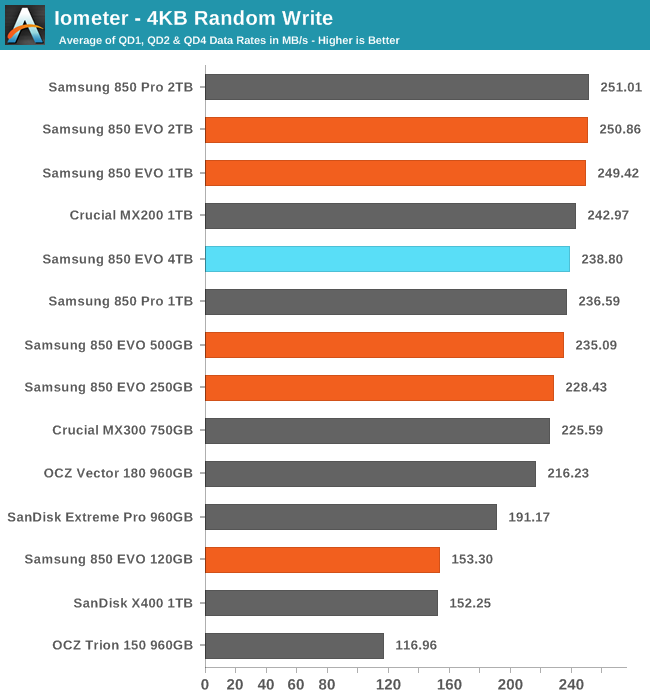
Random write speed for the 4TB 850 EVO is a little bit slower than for the 1TB and 2TB models, but still fast enough to beat almost all non-Samsung drives.
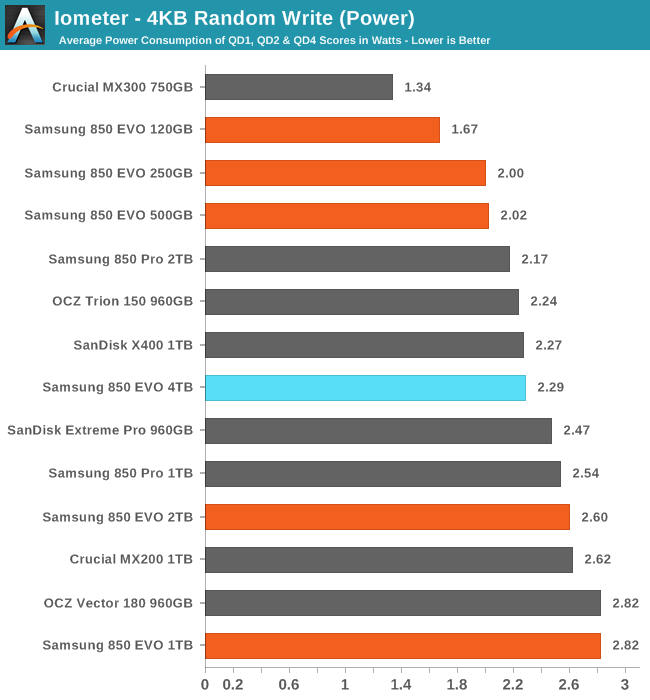
Power consumption of the 4TB 850 EVO is substantially better than the 1TB and 2TB counterparts, making it one of the most efficient large drives. The 750GB Crucial MX300 was still much more efficient.
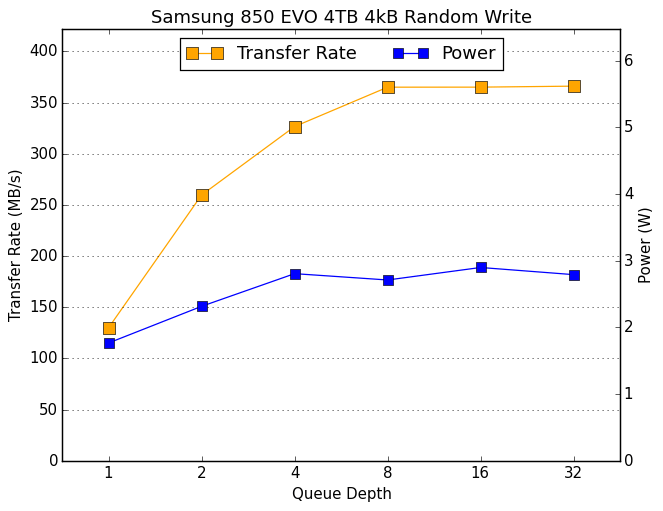 |
|||||||||
The lower performance score for the 4TB was apparently due to a regression in QD4 performance, where the 1TB and 2TB models were able to reach full speed but the 4TB needs a larger queue.










145 Comments
View All Comments
Samus - Monday, July 11, 2016 - link
But you could buy 8TB of MLC-based Mushkin Reactor for the price of 4TB of 850 EVO. Then you consider a RAID of Reactors will be 4x the sequential performance of a 850 EVO.And let's face it, with a storage drive like a 4TB SSD, sequential performance is all that really matters unless you actually plan to use it as a boot/system drive.
ACE76 - Monday, July 11, 2016 - link
http://www.fudzilla.com/news/memory/39668-mushkin-...I can't wait for this...at $500 for 4tb, I'd move all my media over to SSDs in a RAID 10 array.
Ian Cutress - Tuesday, July 12, 2016 - link
We got clarification from Mushkin at the time when we posted similar: the $500 price point was actually a mischaracterization. The initial price would be much closer to $1000, with $500 being a goal nearer EOL.Oxford Guy - Monday, July 11, 2016 - link
How does TRIM fit into the picture of RAIDed ssds, though?Impulses - Tuesday, July 12, 2016 - link
TRIM has been working on RAID for a while, years actually, at least on Intel's newer chipsets... They kept it from older chipsets (like my old rig's P67) but enterprising users back ported it thru BIOS edits/hacks.Impulses - Tuesday, July 12, 2016 - link
Not that I'm against the EVOs, running 2x 1TB in RAID myself.bittermann - Monday, July 11, 2016 - link
Good luck fitting 4TB of data on that 1TB drive....Spoogie - Monday, July 11, 2016 - link
With Optane on the horizon, no reason to bite at this price point.Flunk - Monday, July 11, 2016 - link
I don't think it's the same market. Optane isn't going to be less than $1 a GB at the start.patrickjp93 - Monday, July 11, 2016 - link
65 cents/GB actually.